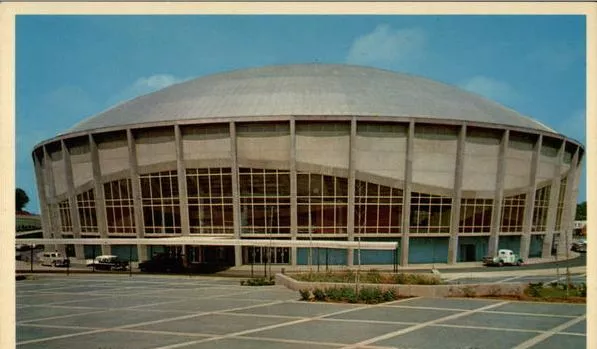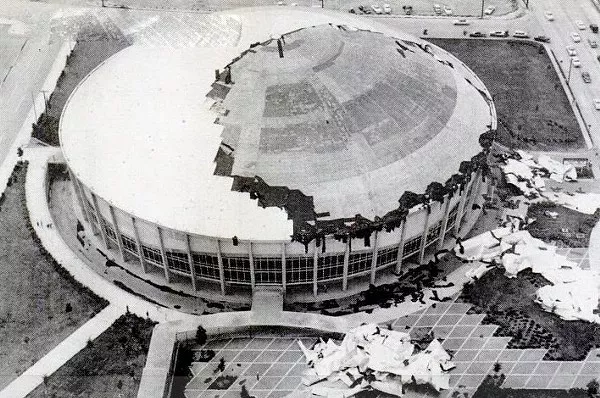Editor's note: In this series, local author David Aaron Moore answers reader-submitted questions about unusual, noteworthy or historic people, places and things in Charlotte. Submit inquires to davidaaronmoore@post.com.
I see it every day on my drive into Uptown from Matthews. Big and round, it looks like a 1950s UFO. I know it's called Bojangles Coliseum now, but what was its original name, and when was it built? - Frank Owens, Matthews
In earlier incarnations it was known as Cricket Arena, after the cellphone company, and even earlier as Independence Arena, before somebody came up with the cheesy idea of selling name-branding rights to performance halls. As much as I enjoy the restaurant chain's chicken, I have to profess that name is just downright corny for an entertainment venue. Not to mention the big, brassy red and yellow Bojangles logo plastered all over it that so do not blend with the classic mid-20th century contemporary architectural style.

But its bones are what matter. Originally, it was the Charlotte Coliseum, but it's important to note that another "Charlotte Coliseum" also once existed. It opened in 1988 and was demolished in 2007, though some people still don't understand why, since it was popular and larger than what's now known as Bojangles' Coliseum. The latter, which was known as Charlotte Coliseum until 1988, is one of the city's few remaining examples of mid 20th century modern design.
Some people adore its ultra '50s appeal, while others find it a monstrous eyesore.
Love it or hate it, it's played a significant role in Charlotte history.
"It has so many memories for so many people," says Julia Smith, a native who recalls when it opened. "It played a very important part in many peoples' lives. I remember going there when I was just a little girl and ice skating with my sisters and my father, seeing the Ringling Brothers and Barnum and Bailey Circus and the Harlem Globetrotters. Years later, my high school graduation was held there."
Smith saw Elvis perform his last Charlotte concert at the coliseum before he died.
The drive to build what's now known as Bojangles' Coliseum began in the late 1940s, when it was brought to the attention of then-Mayor Victor Shaw that notable celebrities of the day like Sonja Henie, Jimmy Durante and Danny Kaye flatly refused to perform in the city because it was lacking a large enough performance space. Half a decade and a few million dollars later, the Odell & Associates-designed coliseum (with the accompanying Ovens Auditorium) opened for the first public viewing in May 1955. The first dedication ceremony, held Sept. 11, 1955, attracted an estimated 13,000 people.
Over the years the site has played host to thousands of performers. Among those that took to the stage between 1955 to 1988 were: Liberace, James Brown, The Monkees, Stevie Wonder, Tina Turner, Bruce Springsteen, The Rolling Stones, The Police, Diana Ross, Elton John, Eric Clapton, The Jackson Five, Van Halen, Def Leopard, Duke Ellington, Jimi Hendrix, Barry Manilow, Kool & The Gang, Eric Clapton, Grateful Dead, KISS, Billy Preston, Ernest Tubb, Santana, INXS and Chicago.
The coliseum also offered more than just musical performances: presidential campaign speeches, basketball games, wrestling matches, numerous conventions (Cub Scouts, Amway, DeSoto dealerships, lumber sales), the Ice Capades, fashion shows, an Esther Williams "Water Show" and numerous Billy Graham "crusades."
One event in 1958 was held shortly after a massive July storm blasted through the city, ripping off large portions of the facility's aluminum top. According to a report in The Charlotte News, the event continued without fail, "despite the presence of water leakage from the recently damaged roof."

- Courtesy of Patrick Richardson
- Despite a 1958 storm that ravaged the coliseum, scheduled events went on
A particularly noteworthy claim to fame: At the time of its construction, the rooftop was the largest free-span dome in the entire world. Articles applauding the accomplishment appeared in such global publications as Look and Architecture and Building.
It shuttered in 1988 and reopened in 2001 with some refreshed period-appropriate retro-renovation and refurbishing.
Moore is the author of Charlotte: Murder, Mystery and Mayhem. His writings have appeared in numerous publications throughout the U.S. and Canada.





